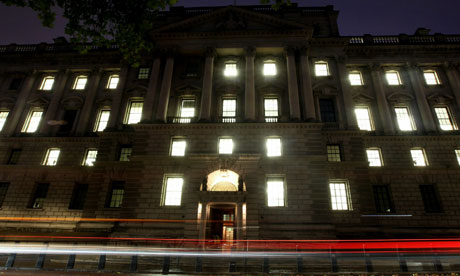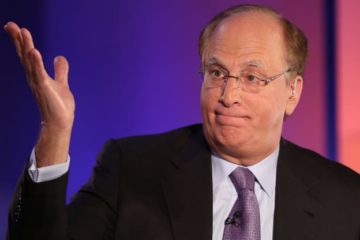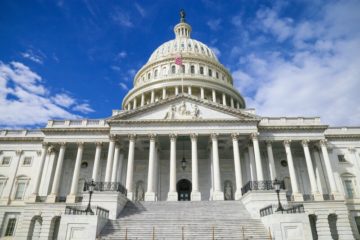Budget 2011: Green bank is coalition’s biggest environmental test

The centrepiece of the coalition’s bid to be “the greenest government ever” will be unveiled in George Osborne’s budget on Wednesday: a green investment bank, primed to invest in low-carbon infrastructure such as renewable energy and the development of new, clean technologies.
The bank has been a long time in gestation because of an almighty row within government between green enthusiasts such as the climate secretary, Chris Huhne, and the Treasury over what powers the bank should have. The result of that tug of war will be arguably the most important green measure announced by the chancellor in his speech at 12.30pm.
The idea of a green bank has been enthusiastically received by green campaigners and the low-carbon technology industry. Penny Shepherd, the chief executive of the UK Sustainable Investment and Finance Association (UKSIFA), said: “Today, the UK is widely recognised as a global leader in green financial services. There is a real risk that our international competitiveness in this growing market will be seriously damaged if we are not seen to recognise the urgency of financing our own low-carbon transition.” A green investment bank would be a key part of that financing, she said.
John Sauven, the executive director of Greenpeace, called the bank “the glue that would hold together the coalition’s entire green programme”.
“The keystone of the government’s green investment policy must be a strong green investment bank,” added Guy Shrubsole, of the Public Interest Research Centre (PIRC).
But campaigners argue that the bank will be introduced in a form that could jeopardise some of its aims. Despite being called a bank, it will lack many of the powers that allow banks to operate – for instance, the chancellor is expected to confirm today that it will not have powers to borrow or raise money until 2015, and it will not be able to issue financial instruments, such as Isas and bonds. The £1bn initial government funding for the bank is less than environmentalists called for, and it is not yet clear what sorts of project the bank will be allowed to invest in. Would it be able to support nuclear power plants, for instance?
According to the PIRC, the UK devoted £12.6bn to green investment in 2009-10, which was less than 1% of GDP and less than half of the sum it is estimated will be needed in annual investment to reform the UK’s energy infrastructure and meet greenhouse gas emissions targets. (It is also, according to the PIRC, less than the amount the UK spends annually on cosmetics and perfume.) The organisation said the bank would need to be funded with £4-6bn, to be effective.
But the green investment bank is likely to be capitalised with only £1bn from the government to begin with, and a further £1bn to £2bn could come from public sector asset sales.
Government finance in the form of a green bank is needed to kickstart the UK’s low-carbon economy, according to financial experts, because private sector banks are unwilling to take risks on new technologies and some large infrastructure projects. The backing of a government-funded bank could help to attract private sector investment, as it would remove some of the risk associated with early-stage investments.
Philip Jones, investment manager at the London Pension Fund Authority, said: “The green investment bank should be a green investment insurance operation. Unless you can insure projects, a lot of them are going to wither on the vine.”
It is unclear whether the bank will be able to act as an insurer of projects in this way. Many of the finer details of how the bank will operate will not be finalised until May.
The bank has been mired in controversy since its inception, because of conflicting ideas within government of what its role should be. According to the original plans laid out by Bob Wigley, the former Merrill Lynch banker and chairman of Yell who was called in by George Osborne to lead the design, the bank should be able to raise equity, borrow money, issue bonds and sell consumers savings products that would allow them to participate in the growing green economy.
But many of those plans have been whittled away. The Treasury is known to be unwilling to allow the bank too much autonomy, fearful of creating a beast it cannot control, and is insistent that the bank should remain on the government’s balance sheet – an insistence that means if the bank were to borrow, that could swell the public sector deficit, though only on paper. The Treasury is firmly against swelling the deficit on any grounds, even if the increase is purely in accounting terms rather than real.
After furious rows between the Treasury and other departments, the compromise reached is that the bank will not be allowed to borrow within the term of this five-year parliament, but will gain such powers from 2015.
That restriction is viewed as catastrophic by some. Joan Walley, Labour MP and chair of the environmental audit committee, which published a report critical of the government’s plans to curtail the role of the bank, said: “It would be a tragedy if the green investment bank were not set up in the way that is needed to deliver the investment needed.”
Ed Matthew, the director of Transform UK, which has campaigned for a green bank, said: “The power to borrow is what gives the green investment bank the ability to leverage in the private investment required to spark low-carbon growth and decarbonise our energy system. If they clip the wings of the green bank so it can’t fly, where is the growth going to come from? Are they going to magic it out of thin air?”
He said: “It seems extraordinary that in terms of delivering a ‘budget for growth’ the government can’t even do something everyone wants. We are in clean-tech race with the rest of the world and the Treasury seems determined to lose.”
Tim Yeo, a Tory MP and former minister, was more sanguine. “The delay is certainly very disappointing, but allowing it to borrow from 2015 is better than nothing.”
Another power the bank will lack, the Guardian has revealed, is the ability to issue “green Isas”. These would be individual savings accounts, which let people save a certain amount each year tax-free, which would be invested in green stocks and shares or green projects.
Finance experts and green campaigners have been disappointed that green Isas – which were first floated by Osborne in 2008 – will no longer be part of the package. Shepherd, of UKSIF, said: “What’s important here is the principle – if the government chooses not to make these available to retail investors, it will have lost the opportunity to build wider support for the low-carbon transition.”
“This is very short sighted,” said Matthew Spencer, of the Green Alliance thinktank. “[The government] has not engaged the public in the mission to rejuvenate the UK’s infrastructure, and a green Isa would have been one way to raise enthusiasm as well as new funds.”


